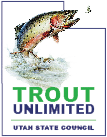Cal Massey
Founder, High Country Fly Fishers | Conservationist | Fly Fishing Mentor

Cal Massey is a trailblazer in Utah’s fly fishing and conservation community. As the founder of High Country Fly Fishers (HCFF), a prominent Trout Unlimited chapter based in Park City, Utah, Cal has dedicated decades to building programs that educate anglers and protect local fisheries.
Cal Massey’s journey into fly fishing began on the coastal waters of South Texas. Growing up in Corpus Christi, Cal spent his early years fishing with his father and brothers using conventional gear, chasing species like sea trout in the bays and inlets of the Gulf Coast. While fishing was already a treasured family activity, Cal’s curiosity about fly fishing first surfaced during high school, reading fly fishing stories in sporting magazines in the school library. Though intrigued by the images of anglers on the rivers of the Pacific Northwest, fly fishing remained a mystery to him—something he would not fully explore until years later.
After marrying Nancy in 1970 and serving as a naval aviator, Cal began a successful career as a commercial airline pilot for Western Airlines and finished with Delta Airlines. It was during this time that fate intervened. On a layover in Idaho Falls, Cal’s fellow crewmates invited him to join them for a fly fishing trip, sparking his interest in a sport he had only read about. Lacking any fly fishing gear, Cal quickly visited the base exchange at NAS Moffett and purchased his first setup: a Fenwick 8.5’ 7-weight rod, reel, and fly line.
Upon arriving in Idaho Falls the following week, Cal and his crew visited Bob’s Fly Shop to stock up on local flies and leaders. There, they encountered Stan Yamamura, an engineer at the Arco site and a respected fly tier whose family supplied shops throughout southeastern Idaho. When Stan overheard their fishing plans, he offered to take them to a better, more productive stretch of water. This serendipitous meeting became a turning point—Stan would become Cal’s mentor and close friend, introducing him to the finer points of fly fishing and fly tying.
For as long as he could, Cal continued to bid for layovers in Idaho Falls, where he and other crewmates spent afternoons fishing the rivers and streams north of town. This period solidified Cal’s passion for fly fishing and deepened his connection to the craft of fly tying under the guidance of Stan and his family.
Back home in Pleasanton, California, Cal expanded his involvement in the fly fishing community by joining the Livermore Fly Fishing Club (LFFC), a well-established organization founded in 1965. His commitment and leadership were quickly recognized, and he rose through the ranks to become club president, overseeing educational programs, conservation initiatives, and family-oriented outings.
In 1989, following the Western-Delta merger, Cal and his family relocated to Park City, Utah. There, another fateful encounter occurred. A friend and former airline colleague, Tom Graue, invited Cal on a float trip down Utah’s famed Green River, a trip purchased at a fundraiser from Jan’s Sports. Accompanied by Jan Peterson himself, the experience was unforgettable and further ignited Cal’s desire to contribute to the Utah fly fishing scene.
Cal soon asked Jan if there was a local fly fishing club in Park City. To his surprise, Jan replied, “There isn’t one—everyone just does their own thing.” Jan offered his mailing list from Jan’s Sports if Cal was interested in starting a club himself. Inspired by his leadership experience with LFFC, Cal decided to take on the challenge.
With the help of Nancy Massey, Cal mailed out flyers, placed a notice in the Park Record, and organized the first meeting of what would become High Country Fly Fishers (HCFF). In December 1989, eight people gathered at the Treasure Mountain Middle School Library for the club’s inaugural meeting, where Cal shared his vision and screened a VHS tape by Lani Waller on steelhead fly fishing.
Recognizing the need to serve not only Park City but neighboring communities like Heber City, Cal and the founding members chose the name High Country Fly Fishers. Cal modeled HCFF after the structure he implemented at LFFC, introducing monthly meetings with guest speakers, beginner fly fishing and fly tying courses, and a club newsletter. The name for the newsletter, “The Scum Line,” came from his daughter Laura, inspired by advice from Cal’s Green River mentors about fishing the back-eddy scum lines.
As HCFF grew, so did its impact. Under Cal’s leadership, HCFF became a regional leader in fly fishing education and conservation. The club initiated numerous conservation projects, including willow plantings to stabilize the Strawberry River watershed, funding and installing steel walkover ladders along the Weber River, and supporting habitat restoration initiatives throughout northern Utah. HCFF also partnered with organizations like Project Healing Waters Fly Fishing to provide therapeutic fishing experiences and rod-building classes for veterans.
Cal’s passion extended beyond club activities. He helped his daughter Laura with her high school science project cataloging aquatic invertebrates in a local spring creek, contributing to her regional and national science fair success. Cal’s influence also cultivated a spirit of mentorship within HCFF, encouraging members to take on leadership roles and advance conservation initiatives.
Throughout the 1990s and beyond, HCFF became one of Utah’s largest and most respected Trout Unlimited chapters. Several of its members have been inducted into the Utah Fly Fishing Hall of Fame, each contributing to projects and programs originally conceived by Cal.
Although Cal eventually passed the presidency to Joe Young, a respected club member, USAF veteran, and POW survivor, Cal remained deeply involved in HCFF’s activities and leadership. His enduring legacy is reflected in the club’s continued success, the vibrant fly fishing community it supports, and the countless anglers and conservationists it has inspired.
Today, Cal Massey continues to serve on the HCFF board, ensuring that the club’s founding principles—community, conservation, and education—remain the foundation of its mission.
